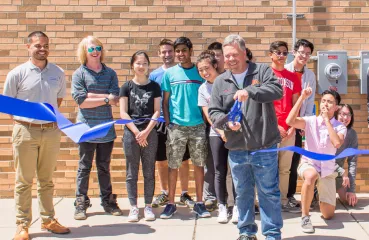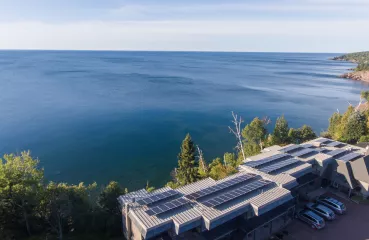Marie Donahue: In recent months, we've experienced unprecedented changes whether from the COVID-19 pandemic or confronting racial injustices, following the murder of George Floyd here in Minneapolis. I know IPS recently made changes to its ownership and name this spring as well from IPS solar to Impact Power Solutions. And I'm curious—how have you, Eric, navigated all of that change in your professional role and how you are feeling about the state and future of clean energy today?
Eric Pasi: I'm very optimistic about the future of clean energy. That's for a set of different reasons, but primarily because the exponential improvements that we're seeing both in efficiency and costs or clean energy is on a pace to dominate the future energy landscape.
As background I've been with IPS for about 13 years. I came straight out of college, out of the University of Minnesota Carlson School of Management and joined IPS right at the precipice of the last global economic turndown. I have seen the incredible transition over the last 10 years as pricing has dropped considerably over 90% for solar panels and the adoption rate has skyrocketed to a point now where—in Minnesota at least—we've increased the total capacity of solar in the last five years by almost a hundred fold.
And so we are seeing that clean energy is not only the most environmentally friendly option, but it's also the most economic economic option and the lowest cost option. Once we've shifted into that paradigm, now the future looks really, really bright.
This year has been a challenge. And I think that’s for many reasons but certainly because of the COVID-19 pandemic, as well as the social and racial injustice injustices that we've seen in the wake of the murder of George Floyd.
Our mantra at IPS since the beginning—just to touch on environmental justice and just solar—has been to increase the opportunities for everybody to participate in the clean energy revolution. Whether that's our work at the Shiloh Temple in North Minneapolis or our work with indigenous tribes in Red Lake. We feel this movement is only going to be as successful as we are in making it as inclusive as possible.
So that we're not exacerbating the energy gap where the people in under-resourced communities don't have access to cheap, clean energy and are subsequently paying more for their energy. We don't want clean energy to be an exacerbating factor toward economic disparities in this country. So we've taken a very active stance to figure out how to accommodate that within our own ethos and within our own projects, as well as industry-wide—promoting other organizations to adopt similar policies.
The pandemic has also thrown us a curveball, where we were on pace for 2020 to be the best year for solar development for our company and in the country in general. What we saw in its wake was closures, widespread closures in March and April of this year, and that was actually at an industry level. We lost a little over 10% of our workforce having been furloughed or let go and the bulk of those job losses were happening at the small business level. That is something that we absolutely need to be mindful of. Small business in this country is the economic engine for growth. The extent that we're losing entrepreneurs and small businesses, that decreases the robustness of our ecosystem. So we want to be mindful of that.


.png)








